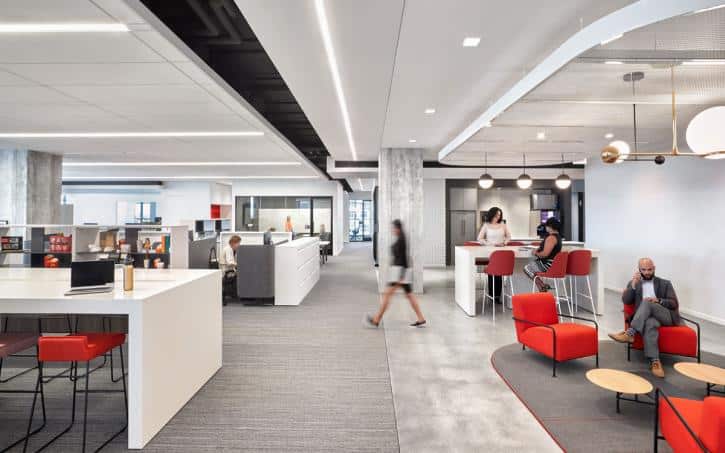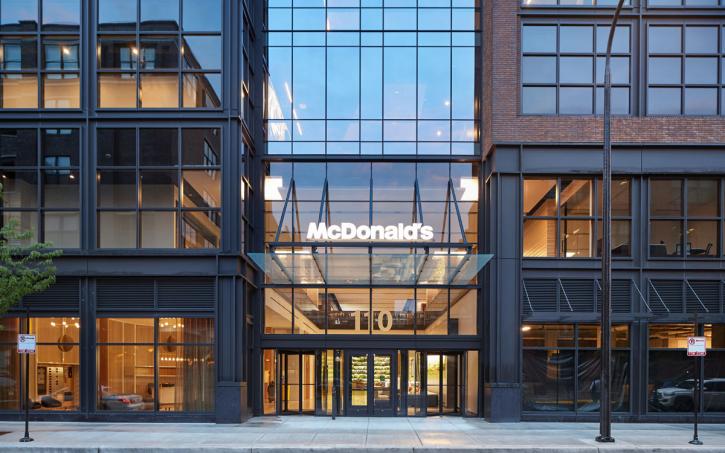









Start of a new era
The Golden Arches has a new address.
On June 4, McDonald’s celebrated the grand opening of its new headquarters in Chicago’s West Loop, a fast-developing neighborhood on the edge of the city’s downtown core.
And McDonald’s CEO Steve Easterbrook holds high hopes for how the company’s new state-of-the-art home will fuel the brand’s future and ignite its ability to connect with consumers.
“Our move back home to Chicago is about more than a building—it’s symbolic of our journey to transform our brand and become more closely connected with our customers,” Easterbrook told the assembled crowd of McDonald’s employees, owner-operators, and suppliers as well as local dignitaries. “Our new location enables us to better listen, learn, and engage with our customers whilst providing a modern, worker-friendly headquarters that fosters collaboration and reenergizes employees.”
Icon meets icon
Though McDonald’s called Chicago home from 1955-1971, the company spent its last 47 years in Oak Brook, Illinois, a suburb 20 miles west of Chicago’s downtown. Chicago Mayor Rahm Emanuel welcomed the return of “the most iconic American brand in the most American of American cities.”
MHQ, as the company’s new nine-story headquarters has been branded, houses some 2,000 employees representing virtually every piece of McDonald’s corporate operation.
Top space, top talent
In creating McDonald’s new headquarters, Easterbrook said company leaders desired a space that would prove attractive to top talent. McDonald’s delivered the mobility that many workers seek with various workspace options that cater to different work styles. Pair that with three outdoor terraces, Thursday happy hours in the ninth-floor City View Bar, and a state-of-the art fitness center and McDonald’s constructed an environment that will help the brand stay relevant to consumers and employees alike.
“You can feel that the energy has changed,” said Brittany McDonough, a six-year McDonald’s employee and co-chair of the company’s Young Professionals Network.
PlayPlaces for work
The sixth floor’s Work Café characterizes the open, collaborative environment that defines McDonald’s new home. Modeled after the “geometry of play,” the Work Café mimics the look and feel of McDonald’s PlayPlaces, a reality emboldened by black fabric netting that stretches over seating along the room’s floor-to-ceiling windows. Work Café also features stadium seating for large groups, an outdoor terrace, an IT Tech Bar for employees’ technological needs, and a barista-style coffee bar modeled after Australian McCafes.
Open for business
Amid its open floor plan, few McDonald’s employees have assigned desks and staff have the ability to maneuver throughout the building to one of 327 meeting or phone rooms, large communal tables, the Work Café, an outdoor terrace, or even the atrium to tackle workday tasks.
“The openness has freed up staff to meet all around the building and we’re seeing discussions everywhere,” McDonald’s chief learning officer Rob Lauber said.
Symbolic design
Scattered around MHQ, “Work Neighborhoods” serve as home bases for different corporate departments. The neighborhoods feature a variety of individual and collaborative workstations as well as personal lockers, huddle rooms, and private phone booths.
Lauber said the work neighborhoods give employees tremendous flexibility to work how they want and symbolize McDonald’s commitment to its people.
Hamburger University
The 490,000-square foot MHQ is also home to McDonald’s flagship Hamburger University, one of seven such company training centers scattered around the globe. Filling MHQ’s second floor—and boasting a separate street entrance to ensure a distinct experience—Hamburger University will host more than 3,000 students each year, all of whom will have their photo displayed on a wall of video screens in the lobby. Students will learn how to prepare food in test kitchens and practice McDonald’s hospitality culture in an adjacent dining area.
Global delight
MHQ’s ground floor features a one-of-a-kind McDonald’s restaurant offering employees as well as the public a rotating menu of favorites from six countries around the globe—the McSpicy Chicken from Hong Kong, the Mighty Angus Original from Canada, and the Italian Mozza Salad from France to name a few—alongside a number of McDonald’s signature classics. The Experience of the Future (EOTF) restaurant also includes many of the elements the brand is weaving into its restaurants, such as self-order kiosks, table service, and McDelivery with Uber Eats.
Paying tribute
From an assortment of Happy Meal toys to old milk shake mixers and vintage memorabilia, McDonald’s rich heritage appears throughout MHQ. The building also includes a tribute wall to McDonald’s groundbreaking leaders, inventors, and owner/operators ranging from iconic chairmen Ray Kroc and Fred Turner to Jim Delligatti, the owner/operator credited with creating the Big Mac, and the chain’s first female owner/operator, Kate Fitzgerald Bagley.
Customers first
In recent years, McDonald’s has unveiled all-day breakfast, upgraded its food quality, and delivered a more contemporary in-store experience to its customers. Company leaders say the new headquarters pushes McDonald’s closer to its customers, competition, and the trends shaping society.
“I fully expect this will have a demonstrable impact on our customers,” McDonald’s USA president Chris Kempczinski said of MHQ.





